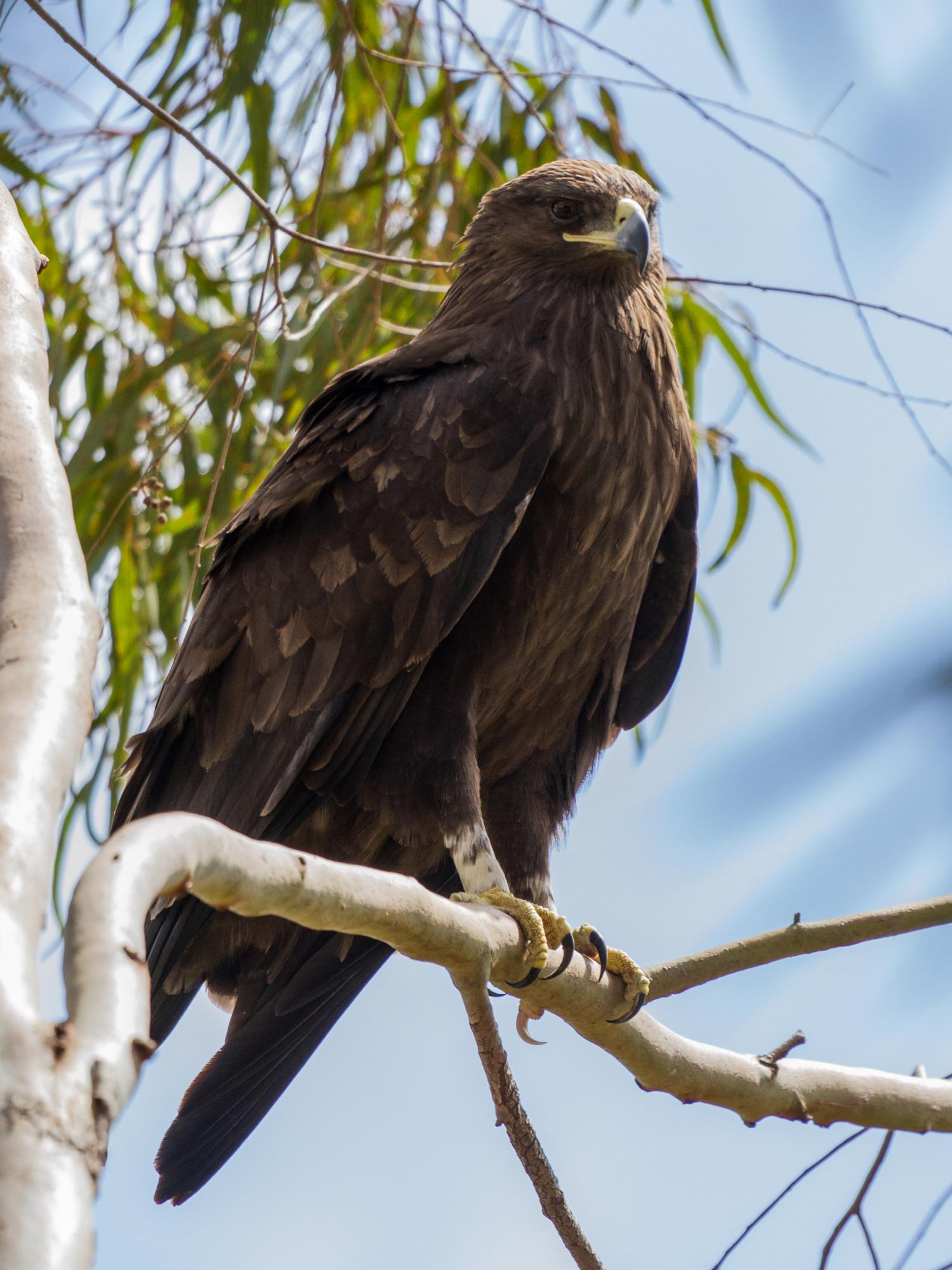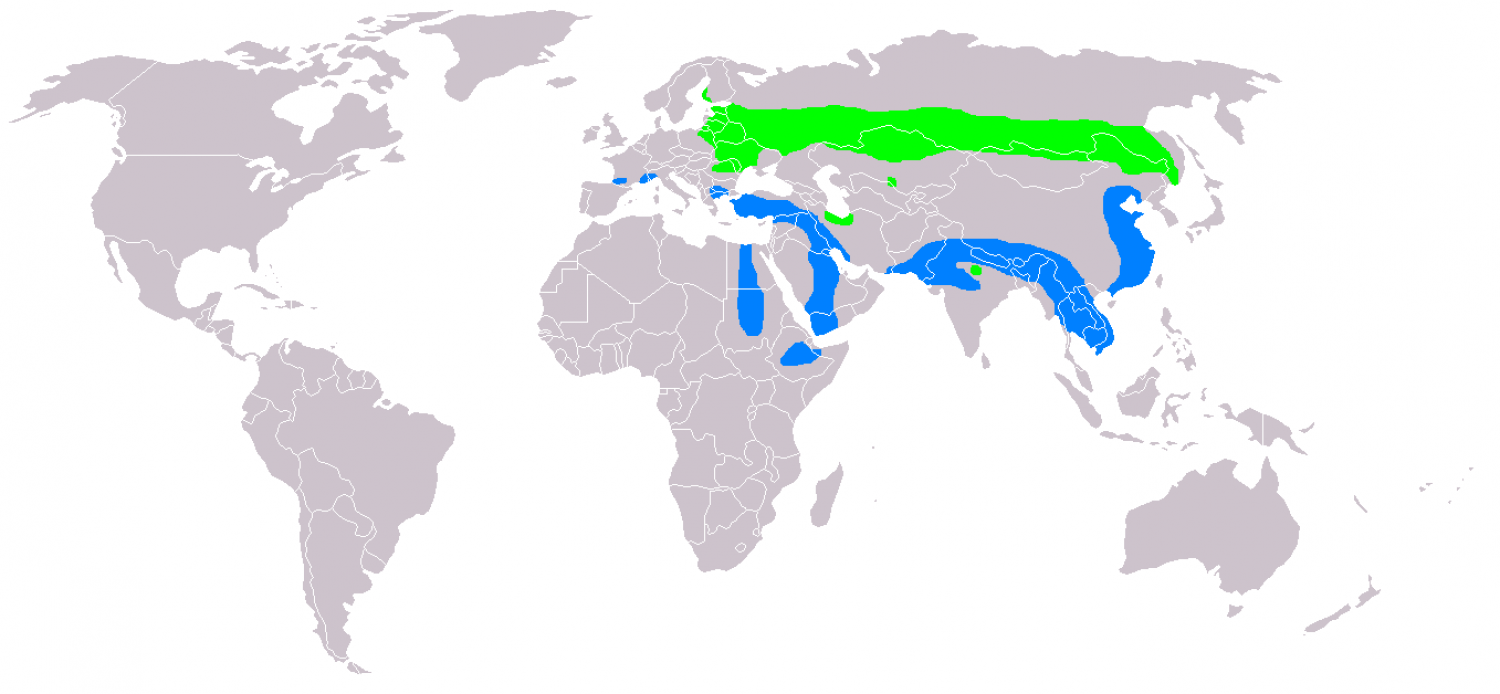Species of Thailand
Greater spotted eagle
Clanga clanga
Peter Simon Pallas, 1811
In Thai: นกอินทรีปีกลาย
The greater spotted eagle (Clanga clanga), occasionally just called the spotted eagle, is a large bird of prey. Like all typical eagles, it belongs to the family Accipitridae. The scientific name clanga is from Ancient Greek κλαγγή, "scream".
Description
The eagle is 59 - 71 cm in abbr=on in length and has a wingspan of 157 - 179 cm ft abbr=on. Typical body mass is 1.6 - 2.5 kg lb abbr=on, with an occasional big female weighing up to 3.2 kg lb abbr=on.
There is often a less obvious white patch on the upperwings, but a light crescent on the primary remiges is a good field mark. The white V mark on the rump is less clear-cut in adults than in the lesser spotted eagle (C. pomarina). The juvenile has white spots all over its wings and lacks a lighter nape patch.
The call is a dog-like yip.
Identification
This medium-sized eagle is very similar in general appearance to its closest relative the lesser spotted eagle, which shares part of its range. Head and wing coverts are very dark brown and contrast with the generally medium brown plumage; the lesser spotted eagle has a paler head and wing coverts. The head is small for an eagle. The similarities of the greater spotted to the lesser spotted often results in misidentification as being that species. This is further complicated by occasional hybrids between the two species.
In winter, it occurs in the range of the Indian spotted eagle (C. hastata). From this recently validated relative, it can be distinguished by the darker color and lighter eye (not darker than the body plumage at distance, lighter at close range), and in juveniles, the strong spotting. It is also a bit larger – though this cannot be reliably estimated in the field – and in the winter quarters prefers wetland habitat.
Systematics, taxonomy and evolution
The typical eagles are often united with the buteos (Buteo), sea eagles (Haliaetus) and other more heavy-set Accipitridae, but they may be less distinct than formerly believed from the more slender accipitrine hawks. The lesser spotted eagle is the greater spotted eagle's closest living relative; their common ancestor seems to have diverged around the middle Pliocene, perhaps some 3.6 million years ago (mya), from the ancestors of the Indian spotted eagle that lives in a band from Iran to and India. The "proto-spotted eagle" probably lived in the general region of Afghanistan, being split into a northern and a southern lineage when both glaciers and deserts advanced in Central Asia as the last ice age began. The northern lineage subsequently separated into the eastern (greater) and western (lesser) species of today, probably around the Pliocene-Pleistocene boundary not quite 2 mya.
The spotted eagles as a group although quite distinct from the typical members, were formerly included in the genus Aquila, the "true eagles". They are now placed in their separate genus Clanga
Distribution and habitat
This is a species of wooded country. The population is entirely migratory. It breeds from northern Europe eastwards across Eurasia, and winters in south-eastern Europe, north-eastern Africa, the Middle East and the Indian Subcontinent. Migration to the breeding grounds takes place fairly late; in Bhutan, for example, birds can be seen with some regularity until the end of March.
Movements
This species is prone to vagrancy. Its regular breeding range no longer extends as far westwards as Germany but birds are still occasionally seen there with a few records per decade. Even young birds disperse widely; the Staatliches Museum für Tierkunde Dresden has a specimen (C 21845) shot in November 1914 near Bernsdorf in Saxony. It is a juvenile, and though its exact age cannot be determined it is heavily spotted and probably less than 20 months old.
An adult greater spotted was tagged with a satellite transponder in 1993 in order to track migration. The tagged eagle migrated a total of 5, 526 km mi abbr=on from its wintering grounds in Yemen to it breeding grounds in western Siberia. It moved 150 km mi abbr=on on average each day, but this increased to 280 km mi abbr=on per day as the bird flew through Mesopotamia.
Behaviour
In its winter range, the species is more social than when breeding. Small flocks of up to ten birds or so, of varying age, can be seen to patrol the land together. They also associate with other Accipitridae such as local and/or migrant black kites (Milvus migrans lineatus and govinda) or steppe eagles (A. nipalensis), distinctly smaller and larger raptors, respectively.
Feeding
The eagle hunts small mammals and similar, mainly terrestrial, prey.
Breeding
This eagle lays 1–3 eggs in a tree nest. Generally territorial, juveniles spend some time with their parents after fledging, until they reach sexual maturity and seek out a territory and a mate of their own.
Status and conservation
It is classified as vulnerable to extinction by the IUCN. As of 2000, the world population of this eagle was estimated at less than 4, 000 breeding pairs. The primary threats are habit degradation and habitat loss, as well as human disturbance during the mating season.
This article uses material from Wikipedia released under the Creative Commons Attribution-Share-Alike Licence 3.0. Eventual photos shown in this page may or may not be from Wikipedia, please see the license details for photos in photo by-lines.
Category / Seasonal Status
Wiki listed status (concerning Thai population): Uncommon passage migrant and winter visitor
BCST Category: Recorded in an apparently wild state within the last 50 years
BCST Seasonal status: Non-breeding visitor
Scientific classification
- Kingdom
- Animalia
- Phylum
- Chordata
- Class
- Aves
- Order
- Accipitriformes
- Family
- Accipitridae
- Genus
- Clanga
- Species
- Clanga clanga
Common names
- Thai: นกอินทรีปีกลาย
Synonyms
- Aquila clanga
Photos
Please help us review the bird photos if wrong ones are used. We can be reached via our contact us page.
Range Map

- Amphawa District, Samut Songkhram
- Ban Laem District, Phetchaburi
- Ban Sang District, Prachinburi
- Bang Saphan Noi District, Prachuap Khiri Khan
- Bueng Boraped Non-Hunting Area
- Chiang Dao District, Chiang Mai
- Chiang Dao Wildlife Sanctuary
- Chiang Saen District, Chiang Rai
- Doi Inthanon National Park
- Doi Lo District, Chiang Mai
- Doi Pha Hom Pok National Park
- Doi Tao District, Chiang Mai
- Kaeng Krachan District, Phetchaburi
- Khao Dinsor (Chumphon Raptor Center)
- Khao Luang National Park
- Khao Sam Roi Yot National Park
- Khao Yai National Park
- Khao Yoi District, Phetchaburi
- Khura Buri District, Phang Nga
- Laem Pak Bia
- Mueang Lopburi District, Lopburi
- Mueang Phetchaburi District, Phetchaburi
- Mueang Phuket District, Phuket
- Mueang Samut Songkhram District, Samut Songkhram
- Nong Bong Khai Non-Hunting Area
- Pak Phli District, Nakhon Nayok
- Pak Thale
- Phaisali District, Nakhon Sawan
- Sakaerat Environmental Research Station
- Taphan Hin District, Phichit
- Thalang District, Phuket



